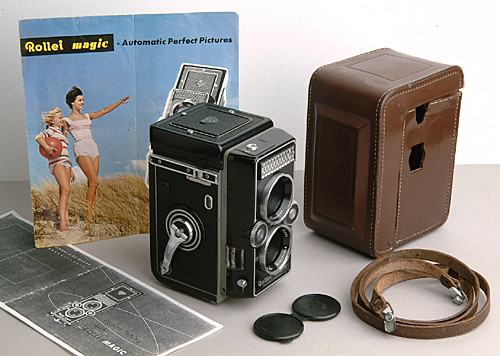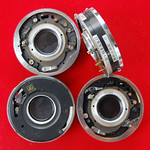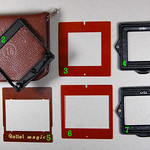Difference between revisions of "Rollei Magic"
Hanskerensky (talk | contribs) (Added image /29504544@N08/6367898259/ from pool) |
(Deleted image by John Nuttall no longer available) |
||
| (5 intermediate revisions by one other user not shown) | |||
| Line 1: | Line 1: | ||
| − | + | ||
| − | + | The '''Rollei magic''' is a [[medium format]] [[TLR]] camera manufactured by [[Franke & Heidecke]], Braunschweig, Germany. | |
| − | |||
| − | |||
| − | |||
| − | |||
| − | |||
| − | |||
| − | The '''Rollei magic''' is a [[medium format]] [[TLR]] camera manufactured by [[Franke & Heidecke]], Braunschweig, Germany | ||
It was Rolleis answer to the desire at that point in time for a TLR with an automated exposure control. | It was Rolleis answer to the desire at that point in time for a TLR with an automated exposure control. | ||
| Line 17: | Line 10: | ||
A big difference with the [[Rolleiflex]] is the fact that the '''Rollei magic''' uses front-cell focusing instead of moving the whole lens board. | A big difference with the [[Rolleiflex]] is the fact that the '''Rollei magic''' uses front-cell focusing instead of moving the whole lens board. | ||
| − | Because many after-sales complaints were received about the lack of a proper manual speed control Rollei came up with a second model, the '''Rollei magic II''' to rectify this | + | Because many after-sales complaints were received about the lack of a proper manual speed control Rollei came up with a second model, the '''Rollei magic II''' to rectify this. |
===Specifications Rollei magic=== | ===Specifications Rollei magic=== | ||
| + | * Production : from 1960 to 1962, about 25.000 units | ||
* Taking lens: [[Schneider]]-Kreuznach Xenar 1:3.5 f=75mm. | * Taking lens: [[Schneider]]-Kreuznach Xenar 1:3.5 f=75mm. | ||
* Viewing lens: Heidosmat 1:3.5 f=75mm (also a Xenar). | * Viewing lens: Heidosmat 1:3.5 f=75mm (also a Xenar). | ||
| Line 29: | Line 23: | ||
* Lighmeter system : [[Selenium]] cell | * Lighmeter system : [[Selenium]] cell | ||
* [[Film speed]] settings : 12 to 1600 [[ASA]]. | * [[Film speed]] settings : 12 to 1600 [[ASA]]. | ||
| − | * | + | * Dimensions WxDxH: 88 x 106 x 147 mm |
* Weight: 1000 grams | * Weight: 1000 grams | ||
{{br}} | {{br}} | ||
| − | ===Specifications Rollei magic II | + | ===Specifications Rollei magic II=== |
{{Flickr_image | {{Flickr_image | ||
|image_source= http://www.flickr.com/photos/90900361@N08/15903624386/in/pool-camerawiki/ | |image_source= http://www.flickr.com/photos/90900361@N08/15903624386/in/pool-camerawiki/ | ||
| Line 42: | Line 36: | ||
|image_rights= wp | |image_rights= wp | ||
}} | }} | ||
| + | <i>Only differences with Rollei magic shown</i> | ||
| + | * Production : from 1962 to 1968, about 12.600 units | ||
* Shutter: [[Prontor]] Prontormat-S model 602 k. | * Shutter: [[Prontor]] Prontormat-S model 602 k. | ||
* Automatic exposure: speeds 1/30 to 1/500 sec. at diaphragms 3.5 to 22. | * Automatic exposure: speeds 1/30 to 1/500 sec. at diaphragms 3.5 to 22. | ||
| Line 66: | Line 62: | ||
== Bibliography == | == Bibliography == | ||
| − | * Claus Prochnow, Rollei Report 2, third edition, | + | * Claus Prochnow, Rollei Report 2, third edition, Braunschweig, Lindemanns Verlag, 2008, <nowiki>ISBN</nowiki> 3-89506-220-0. |
| − | |||
== Links == | == Links == | ||
| + | *[https://www.butkus.org/chinon/rollei/rollei-magic_ii/rollei-magic_ii.htm Rollei Magic and Magic II user manuals] at [https://www.butkus.org/chinon/ Butkus.org] | ||
*[http://www.rolleiclub.com/cameras/tlr/info/magic.shtml Rollei Magic page] at [http://www.rolleiclub.com/ Rolleiclub.com] | *[http://www.rolleiclub.com/cameras/tlr/info/magic.shtml Rollei Magic page] at [http://www.rolleiclub.com/ Rolleiclub.com] | ||
| Line 76: | Line 72: | ||
[[Category: Rollei]] | [[Category: Rollei]] | ||
[[Category: R]] | [[Category: R]] | ||
| + | [[Category: M|Magic Rollei]] | ||
Latest revision as of 06:39, 10 April 2023
The Rollei magic is a medium format TLR camera manufactured by Franke & Heidecke, Braunschweig, Germany.
It was Rolleis answer to the desire at that point in time for a TLR with an automated exposure control. Rollei could achieve this when the shutter company Prontor designed a new shutter for just that purpose, the Prontormat-S.
The Rollei magic uses 120 type Rollfilm. 12 6x6cm square images can be captured for each roll of 120 film.
By using a special mask set the camera can be adapted to shoot 16 images 4x4 or 4x5.5cm on a roll. The mask put into the filmgate does automaticly change the frame counter from 12 to 16 exposures.
A big difference with the Rolleiflex is the fact that the Rollei magic uses front-cell focusing instead of moving the whole lens board.
Because many after-sales complaints were received about the lack of a proper manual speed control Rollei came up with a second model, the Rollei magic II to rectify this.
Specifications Rollei magic
- Production : from 1960 to 1962, about 25.000 units
- Taking lens: Schneider-Kreuznach Xenar 1:3.5 f=75mm.
- Viewing lens: Heidosmat 1:3.5 f=75mm (also a Xenar).
- Filter Bayonet : Both lenses, size 2.
- Shutter: Prontor Prontormat-S model 565 k1.
- Automatic exposure: speeds 1/30 to 1/300 sec. at diaphragms 3.5 to 22.
- Manual shutter settings : Flash 1/30 sec. and B, both allowing diaphragms 3.5 to 22.
- Lighmeter system : Selenium cell
- Film speed settings : 12 to 1600 ASA.
- Dimensions WxDxH: 88 x 106 x 147 mm
- Weight: 1000 grams
Specifications Rollei magic II

|
| Rollei Magic (II) image by Geoff Harrisson (Image rights) |
Only differences with Rollei magic shown
- Production : from 1962 to 1968, about 12.600 units
- Shutter: Prontor Prontormat-S model 602 k.
- Automatic exposure: speeds 1/30 to 1/500 sec. at diaphragms 3.5 to 22.
- Manual shutter settings : 1/30 sec. to 1/500 and B, both allowing diaphragms 3.5 to 22.

|
| Prontormat-S 602k shutter image by Hans Kerensky (Image rights) |

|
| 16 images mask set image by Hans Kerensky (Image rights) |
Bibliography
- Claus Prochnow, Rollei Report 2, third edition, Braunschweig, Lindemanns Verlag, 2008, ISBN 3-89506-220-0.